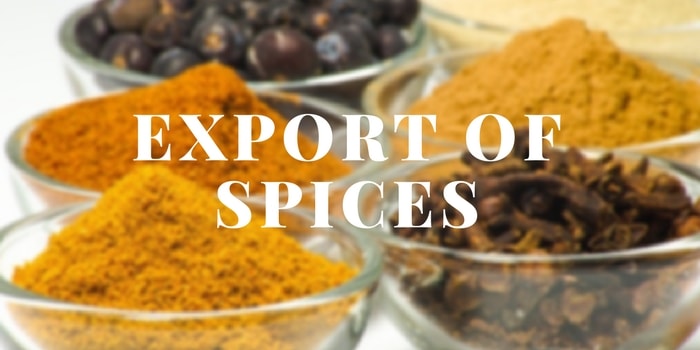Starting Export Of Spices From India – Profitable Business Opportunity

India has since years been known for its quality spices that it produces and exports to whole world. The aroma, taste, quality, texture and medicinal value makes Indian spices as one of the most sought after spices in the world. Presently, India is the largest producer and exporter of spices in the world. Most of these spices are produced in small land plots owned by farmers. India produces 75 of the 109 varieties of spices mentioned in International Standard Organization.
India is also the largest consumer of spices given every Indian dish has some quantity of Indian spices. In the financial year 2016-17, India exported 947790 tons of spices that valued $2.63 billion. Indian export of spices also registered 6% growth on year on year basis in terms of value. India exports most of its spices to United States, Vietnam, Sri Lanka, United Kingdom, United Arab Emirate, Saudi Arabia, Germany, Indonesia, China, and Malaysia.
India exports major spices like cardamom, pepper, chilli, coriander, cumin, ginger, turmeric, celery, fenugreek, ajwain, fennel, dill seed, nutmeg, clove, tamarind, and garlic. The spice board of India maintains all the records related to spice production, consumption and export.
If you want to start export business of spices from India then very good opportunity is here. Below is the list of top 10 spices exported from India.
Top Ten Spices Exported from India:
Chilli: In the FY 2016-17, India exported the maximum amount of Chilli in the spice category. India exported 400250 tons of Chilli to the world. India earned a total of Rs 507075 lakh. The major importer of Indian Chilli were Vietnam, Thailand, Malaysia, Sri Lanka, and USA. India exported the largest amount of Chilli to Vietnam at the cost of Rs 95929 lakhs while India exported Rs 96101 lakh worth of chilli to Thailand. The growth in export is in positive as it is more than previous year’s export.
Also Read:- List of agricultural products exported from India to other countries
Mint Products: India is also a leading exporter of mint products to the world. India exported 22300 tons of mint in FY 2016-17 to many countries that had a total worth of Rs 252750 lakh. China, United States, Netherlands, Germany, and France are the leading importers of Indian mint. India exported 9359.55 tons of mint to China while it exported 3130.37 tons of mint to USA. 951.07 tons of mint was exported to Netherlands while 667.68 tons of mint was exported to Germany. In the FY 2015-16, 21150 tons of mint was exported to the world.
Spice Oils and Oleores: India is also a leading exporter of spice oils and oleores in terms of values. India exported 12100 tons of spice oil and oleores that had a total worth of Rs 230775 lakhs. United States, Germany China, South Korea and United Kingdom are the leading importers. USA imported 3041 tons with a total worth of Rs 78692 lakhs. China exported 1496.98 tons that cost Rs 18920 lakhs. In FY 2015-16, India exported 11635 tons of spice oil and oleores that gained India Rs 214255 lakhs.
Cumin: India is one of the largest exporters of cumin that is produced across India. India in FY 2016-17 exported 119000 tons of cumin to the world earning Rs 196320 lakhs. Vietnam, USA, UAE, Bangladesh and UK are the leading importers of Indian cumin. Vietnam imported 38872.60 tons of cumin for Rs 65333.08 lakhs while USA imported 11548.32 tons of cumin for Rs 21961.61 lakhs. Bangladesh was on third rank with 10067.02 tons of import at Rs 14200.09 lakhs. 97790 tons of cumin was exported in FY 2015-16 by India, a little less than the FY 2016-17.
Turmeric: India leads the way in turmeric export in the world. In FY 2016-17, India exported a total of 116500 tons of turmeric to the world at Rs 124189 lakhs. In FY 2015-16, India exported 88500 tons of turmeric at Rs 92165 lakhs. Iran, USA, Bangladesh, UAE and Malaysia are the leading importers of Indian turmeric. India exported the largest to Iran 14862.40 tons of turmeric at Rs 13575.50 lakhs.
Pepper: India is also a leading exporter of pepper. Pepper is mostly grown in Southern India. India exported 17600 tons of pepper at Rs 114312.50 lakhs. USA, UK, Sweden, Germany and Japan are leading importers of Indian pepper. India exported the largest pepper supply to USA. 9700 tons of pepper was exported to USA at Rs 58200 lakhs. In FY 2015-16, India exported 28100 tons of pepper at Rs 173041.50 lakhs.
Curry Powder Paste: Curry Powder paste is a type of spice that is used to prepare Indian style curry which is world famous. India is a leading exporter in curry powder paste. India exported 28500 tons of curry powder paste at Rs 59910 lakhs in the FY 2016-17. India exported 26550 tons in FY 2015-16 at Rs 53174.50 lakhs. USA, Saudi Arabia, United Kingdom, UAE and Qatar are the largest importer of Indian curry powder and paste. USA, the largest importer imported 2863.98 tons at Rs 7193.27 lakhs.
Cardamom (small): India is one of the leading producers and exporter of cardamom and it has extensive usage. India exported 3850 tons of cardamom at Rs 42150 lakhs in FY 2016-17 while in FY 2015-16, India exported 5500 tons of cardamom at Rs 44982.75 lakhs. Saudi Arabia, Kuwait, USA, Japan and UAE are the leading importers of Indian cardamom.
Cardamom (Large): There are two types of cardamom. One is large and other is small. India exported 780 tons of cardamom large at Rs 8265.50 lakhs in FY 2016-17. Pakistan, UAE, Unite Kingdom and United States are the leading importers of cardamom large.
Coriander: India has been a hub of coriander in production, consumption and export. India exported 30300 tons of coriander at Rs 29207.50 lakhs in FY 2016-17. Malaysia, United Kingdom, USA and South Africa are the leading importers of Indian coriander. India exported the highest stock of coriander of 12162.42 tons at Rs 10635.78 lakhs.
Other Spices: India also exports various other spices that have a huge share of export. India exported 40210 tons at Rs 50595 lakhs in FY 2016-17. In FY 2015-16, India exported 43955 tons at Rs 58348.50 lakhs which was higher than FY 2016-17. There are series of countries that import such Indian spices.
Apart from these ten, India has been exporter of many other spices like ginger, celery, fennel, fenugreek, garlic, etc. to many countries across the world. Indian market of export has been rising every year. As latest, the growth year on year basis is 6% which is expected to grow at good pace in future as well.
FAQS
The most popular spices exported from India include cardamom, cloves, cumin, nutmeg, and pepper.
The benefits of exporting spices from India are numerous. India is the world’s largest producer and exporter of spices, and the country’s spices are in high demand around the world. Indian spices are known for their quality and unique flavor, and they are used in a variety of cuisines. Exporting spices from India allows spice producers and exporters to tap into a global market and earn a good income. Additionally, exporting spices from India helps to promote the country’s image and cuisine around the world.
The top markets for Indian spices are the United States, the United Kingdom, Canada, and Australia.
There are a few things you need to do in order to get started in exporting spices from India:
1. Find a reliable source for your spices. This can be either a spice company or a farmer.
2. Make sure your spices are of good quality and are free from contaminants.
3. Choose the right packaging for your spices. This will ensure that the spices retain their freshness and flavor during transport.
4. Find a good logistics company that can help you with the shipping and exporting process.
The most common problems faced by spice exporters from India include:
1. Lack of quality control: There is no central authority in India that regulates the quality of spices produced in the country. As a result, there is a wide variation in the quality of spices produced in different parts of the country. This makes it difficult for spice exporters to meet the quality standards of their overseas customers.
2. Lack of standardization: There is no uniformity in the quality of spices produced in different parts of the country. This makes it difficult for spice exporters to meet the quality standards of their overseas customers.
3. Pest infestation: Pests are a major problem faced by spice exporters from India. Spices are susceptible to infestation by a variety of pests, which can damage the quality of the product.
4. Adulteration: Adulteration is another major problem faced by spice exporters from India. Spices are often adulterated with cheaper substitutes, which can impact the quality of the product.
The best way to ensure the quality of your spices when exporting from India is to work with a reputable supplier who can provide you with a certificate of analysis for the spices you are interested in. This certificate should include information on the purity and potency of the spices, as well as any potential contaminants. You should also request a sample of the spices before making a large purchase, so that you can inspect the quality for yourself.
The most common issues faced when exporting spices from India are:
1. Ensuring that the spices are of high quality
2. Meeting international food safety standards
3. Ensuring that the spices are properly packaged
4. Managing the logistics of exporting the spices
The future prospects for exporting spices from India are good. India is the world’s largest producer and exporter of spices, and the country’s spices sector is growing rapidly. India’s spices sector is expected to grow at a compound annual growth rate of 7.5% between 2018 and 2021. The Indian spices sector is highly competitive, and the country’s spices are in high demand in international markets.






